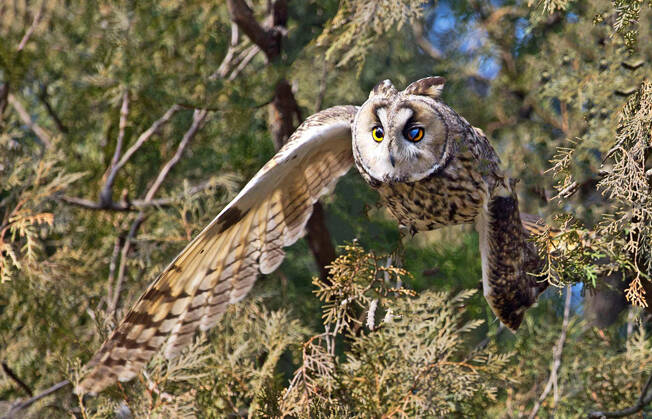Asio otus
IUCN
LCBasic Information
Scientific classification
- name:Asio otus
- Scientific Name:Asio otus,Long-eared Owl,Northern Long-eared Owl,Strix otus Linnaeus, 1758,Long-eared wooden rabbit, with headset Elvis, tiger eagle, Biaomu rabbit, night owl, owl
- Outline:Raptor
- Family:Strigiformes Owl
Vital signs
- length:33-39cm
- Weight:208-326g
- lifetime:About 10-20 years
Feature
The ear feathers are long and located on both sides of the head, standing upright like ears.
Distribution and Habitat
Distributed in Afghanistan, Albania, Algeria, Andorra, Armenia, Austria, Azerbaijan, Belarus, Belgium, Bosnia and Herzegovina, Bulgaria, Canada, China, Croatia, Cyprus, Czech Republic, Denmark, Egypt, Estonia, Faroe Islands, Finland, France, Georgia, Germany, Greece, Hungary, India, Islamic Republic of Iran, Republic of Iraq, Ireland, Israel, Italy, Japan, Jordan, Kazakhstan, North Korea, South Korea, Kyrgyzstan, Latvia, Lebanon, Liechtenstein, Lithuania, Luxembourg, Kingdom of Macedonia, Malta, Mexico, Moldova, Mongolia, Montenegro, Morocco, Netherlands, Norway, Pakistan, Palestine, Poland, Portugal, Romania, Russia, Serbia, Slovakia, Slovenia, Spain, Sweden, Switzerland, Syrian Arab Republic, Tajikistan, Tunisia, Turkey, Turkmenistan, Ukraine, United Arab Emirates, United Kingdom, United States, Uzbekistan.
Migrant birds: Bermuda Islands, Bhutan, Cuba, Gibraltar, Hong Kong, Iceland, Kuwait, Lao People's Democratic Republic, Myanmar, Nepal, Oman, Qatar, Saint Pierre and Miquel
Appearance
The face plate is obvious, the middle part is white mixed with dark brown, the sides of the face plate are brown and the feather stems are white, the barbules are loose, and the forehead is white and brown mixed. There are dark spots on the inner side and upper and lower edges of the eyes. The ruff is white and the tips of the feathers are dark brown. The ear feathers are well developed, about 50 mm long, located on both sides of the head, significantly protruding from the head, shaped like two ears, dark brown, with brown on both sides of the feather base, and a brown edge on the inner flap. White spots. The upper body is brown with thick dark brown feather shaft lines. The sides of the feather tips are densely covered with brown and white fine lines. The upper back is lighter in brown color and gradually becomes thicker later. The dark brown markings on the feather tips are also numerous and obvious. The shoulders The feathers are the same as the back, but the base of the feathers is
Details
The long-eared owl is called Long-eared Owl in foreign language, and there are 4 subspecies.

The long-eared owl mainly feeds on rodents such as mice, and also eats small birds, mammals and insects. Such as finches, warblers, bats, beetles, beetles, locusts, mole crickets, etc.
The call of the long-eared owl: The male bird makes a vague ooh call, about once every two seconds. The female bird responds with a relaxed nasal sound paah. The warning call is kwek, kwek. When begging for food, the young birds make a long and sad peee-e sound. During the breeding season, they often call at night, and their sound is low and long, like a repeated "hu-hu-".
The breeding season of the long-eared owl is from April to June, and they like to call especially at this time. Because they mostly show off their courtship at night, the way they do it is relatively simple, and they can only do some close-range performances, such as bowing, flapping wings, kissing each other, preening feathers, etc. Sometimes they also flutter their wings, make a strange crackling sound in their mouths, and take turns to switch their feet. They nest in the forest, usually using the old nests of crows, magpies or other birds of prey, and sometimes nest in tree holes. Each nest lays 3-8 eggs, usually 4-6 eggs. The eggs are white, oval, 39-45 mm × 32-35 mm in size, 43 mm × 33 mm on average, and weigh 19.6 grams.
The incubation process is entirely undertaken by the female bird, and the incubation period is 27-29 days. Its chicks are late-maturing and leave the nest 45-50 days after hatching.
The migration behavior of migratory birds is more affected by food factors than other migratory birds with stable phenology. For example, a group of long-eared owls overwintering have been recorded in Shenyang in the northeast, while the time and location of long-eared owls in other wintering areas are not very stable. In addition, food also affects the reproductive success rate of long-eared owls and their population size.
Listed as a Class II protected animal in the Washington Convention.
Listed in the China National Class II Key Protected Wildlife List in 1989.
Listed in the 2012 Red List of Endangered Species of the World Conservation Union (IUCN) ver 3.1 - Least Concern (LC).
Listed in the Class II of the China National Key Protected Wildlife List.
Protect wild animals and stop eating game.
Maintaining ecological balance is everyone's responsibility!








